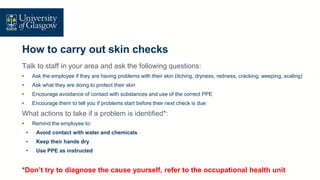Dermatitis is a common occupational skin disease caused by repeated skin irritation or sensitization. Symptoms include redness, itching, rash, inflammation, cracking or peeling. There are two main types: irritant contact dermatitis caused by exposure to irritants, and allergic contact dermatitis where the body develops an allergy. Risks at work include wet work, chemicals, solvents, gloves, and metals. To reduce risk, avoid skin contact where possible, use protective equipment, and check skin regularly for early signs of dermatitis with health surveillance if required.







